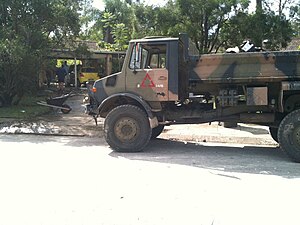Operation Queensland Flood Assist
| Operation Queensland Flood Assist | |
|---|---|
| Part of 2010–2011 Queensland floods | |

An Australian Army truck assisting with the cleanup of a flood affected suburb of Brisbane
|
|
| Type | National emergency response contingency |
| Location | Flood affected areas of Queensland |
| Planned by | Emergency Management Australia (EMA) |
| Target | Search & Rescue, evacuation, health management, airlift, provision of supplies, logistics operations, reestablishment of emergency communications, hydro-graphic survey, underwater clearance, recovery and reconstruction |
| Date | 1 January 2011 – 4 February 2011 |
| Executed by | Joint Task Force 637 |
Operation Queensland Flood Assist is a complex, multi-Service activity by the Australian Defence Force (ADF) as a contribution to the response to the 2010–2011 Queensland floods. Coordinated to aid civilian emergency response efforts, at Federal inter-departmental level it is managed by Emergency Management Australia. It comprises units and personnel from the Royal Australian Navy (RAN), Australian Army, and Royal Australian Air Force (RAAF) operating as Joint Task Force 637 (JTF 637). The operation was initially commanded by Colonel Luke Foster, based at Enoggera Barracks in Brisbane. When the ADF commitment was increased, command was transferred to Brigadier Paul McLachlan, Commander of the 7th Brigade, also based in Brisbane.
Task force activities were coordinated with the civilian Queensland Recovery and Reconstruction taskforce headed by Major-General Michael Slater.
JTF 637 was established on 1 January 2011 to command the ADF units responding to the floods. At this time, these units included three Army Black Hawk helicopters, which were operating near the town of Emerald. Additional ADF units were assigned to the task force as the situation worsened, and by 14 January, the task force comprised:
On 13 January, ADF units assigned to JTF 637 were operating from Brisbane, Rockhampton, Townsville, RAAF Base Amberley, Roma, Theodore, St George and the Lockyer Valley.
...
Wikipedia
